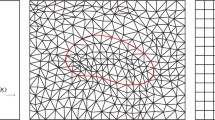Abstract
In this paper, we propose an immersed solid system (ISS) method to efficiently treat the fluid–structure interaction (FSI) problems. Augmenting a fluid in the moving solid domain, we introduce a volumetric force to obtain the correct dynamics for both the fluid and the structure. We further define an Euler–Lagrange mapping to describe the motion of the immersed solid. A weak formulation (WF) is then constructed and shown to be equivalent to both the FSI and the ISS under certain regularity assumptions. The weak formulation (WF) may be computed numerically by an implicit algorithm with the finite element method, and the streamline upwind/Petrov–Galerkin method. Compared with the successful immersed boundary method (IBM) by Peskin and co-workers (J Comput Phys 160:705–719, 2000; Acta Numerica 11:479–517, 2002; SIAM J Sci Stat Comput 13(6):1361–1376, 1992) the ISS method applies to more general geometries with non-uniform grids and avoids the inaccuracy in approximating the Dirac delta function
Similar content being viewed by others
References
Babuska I (1971) Error-bounds for finite element method. Numer Math 16:322–333
Bathe KJ, Zhang H (2004) Finite element developments for general fluid flows with structural interactions. Int J Numer Meth Eng 60(1):213–232
Belytschko TB, Liu WK, Moran B (2000) Nonlinear finite elements for continua and structures, Chapt 7. Wiley, New York
Brezzi F (1974) On the existence, uniqueness and approximation of saddle-point problems arising from Lagrange multipliers. RAIRO Anal Numer R-2:129–151
Brooks AN, Hughes TJR (1982) Streamline upwind/Petrov-Galerkin formulations for convection dominated flows with particular emphasis on the incompressible Navier-Stokes equations. Comp Methods Appl Mech Eng 32:199–259
Feng ZG, Wang X, Michaelides EE (2003) A new approach to treat the solid-fluid boundary conditions in lattice boltzmann method. In: 7th US national congress on computational mechanics
Gay M, Zhang L, Liu WK (2005) Angioplasty stent modeling using Immersed Finite Element Method. Comput Methods Appl Mech Eng (submitted)
Hu HH, Patankar NA, Zhu MY (2001) Direct numerical simulations of fluid-solid systems using the arbitrary Lagrangian-Eulerian technique. J Comput Phys 169:427–462
Huerta A, Liu WK (1988) Viscous flow with large free surface motion. Comput Methods Appl Mech Eng 69:277–324
Hughes TJR, Franca LP, Balestra M (1986) A new finite element formulation for computational fluid dynamics: V. Circumventing the Babuska–Brezzi condition: A stable Petrov–Galerkin formulation of the Stokes problem accommodating equal-order interpolations. Comput Methods Appl Mech Eng 59:85–99
Hughes TJR, Liu WK, Zimmerman TK (1981) Lagrangian-Eulerian finite element formulations for incompressible viscous flows. Comput Methods Appl Mech Eng 29:329–349
Johnson AA, Tezduyar TE (1999) Advanced mesh generation and update methods for 3d flow simulations. Comput Mech 23:130–143
Lai MC, Peskin CS (2000) An immersed boundary method with formal second-order accuracy and reduced numerical viscosity. J Comput Phys 160:705–719
Li S, Liu WK (2004) Meshfree Particle Methods: Chapt 8. Springer, Berlin Heidelberg New York
Liu WK (1981) Finite element procedures for fluid-structure interactions and application to liquid storage tanks. Nucl Eng Des 65:221–238
Liu WK, Gvildys J (1986) Fluid-structure interaction of tanks with an eccentric core barrel. Comput Methods Appl Mech Eng 58:51–77
Liu WK, Karpov EG, Park HS (2005) Nano mechanics and materials : theory, multiple scale analysis, and applications. Springer, Berlin Heidelberg New York
Liu WK, Ma DC (1982) Computer implementation aspects for fluid-structure interaction problems. Comput Methods Appl Mech Eng 31:129–148
Liu WK, Liu Y, Farrell D, Zhang L, Wang X, Fukui Y, Patankar N, Zhang Y, Bajaj C, Lee J, Hong J, Chen X, Hsu H (2005) Immersed finite element method and applications to biological systems. Comput Methods Appl Mech Eng (accepted)
Liu Y, Chung J, Liu WK, Ruoff R (2005) Dielectrophoretic assembly of nanowires: simulation using immersed electrohydrodynamics (in preparation)
Liu Y, Zhang L, Wang X, Liu WK (2004) Coupling of Navier–Stokes equations with protein molecular dynamics and its application to hemodynamics. Int J Numer Methods Fluids 46:1237–1252
McQueen DM, Peskin CS (1997) Shared-memory parallel vector implementation of the immersed boundary method for the computation of blood flow in the beating mammalian heart. J Supercomput 11:213–236
Peskin CS (1977) Numerical analysis of blood flow in the heart. J Comput Phys 25:220–252
Peskin CS (2002) The immersed boundary method. Acta Numerica 11:479–517
Peskin CS, McQueen DM (1989) A three-dimensional computational method for blood flow in the heart. I. Immersed elastic fibers in a viscous incompressible fluid. J Comput Phys 81(2): 372–405
Peskin CS, McQueen DM (1993) Computational biofluid dynamics. Contemporary Math 141:161–186
Stein K, Benney R, Kalro V, Tezduyar TE, Leonard J, Accorsi M (2000) Parachute Fluid- Structure Interactions: 3-D Computation. Comput Methods Appl Mech Eng 190:373–386
Tezduyar TE (1992) Stabilized finite element formulations for incompressible-flow computations. Adv Appl Mech 28:1–44
Tezduyar T, Aliabadi S, Behr M, Johnson A, Mittal S (1993) Parallel Finite Element Computation of 3D Flows. Comput 26: 27–36
Tezduyar TE, Sathe S (2004) Enhanced-Discretization Space-Time Technique (EDSTT). Comput Methods Appl Mech Eng 193:1385–1401
Tezduyar TE (2001) Finite element methods for flow problems with moving boundaries and interfaces. Archives Comput Methods Eng 8(2):83–130
Tu C, Peskin CS (1992) Stability and instability in the computation of flows with moving immersed boundaries: A comparison of three methods. SIAM J Sci Stat Comput 13(6):1361–1376
Wagner GJ, Ghosal S, Liu WK (2003) Particulate flow simulations using lubrication theory solution enrichment. Int J Numer Methods Eng 56:1261–1289
Wagner GJ, Moës N, Liu WK, Belytschko T (2001) The extended finite element method for rigid particles in stokes flow. Int J Numer 51:293–313
Wang X, Liu WK (2004) Extended immersed boundary method using FEM and RKPM. Comput Methods Appl Mech Eng 193(12–14):1305–1321
Zhang L, Gersternberger A, Wang X, Liu WK (2004) Immersed finite element method. Comput Methods Appl Mech Eng 193:2051–2067
Author information
Authors and Affiliations
Corresponding author
Rights and permissions
About this article
Cite this article
Liu, W.K., Kim, D.W. & Tang, S. Mathematical foundations of the immersed finite element method. Comput Mech 39, 211–222 (2007). https://doi.org/10.1007/s00466-005-0018-5
Received:
Accepted:
Published:
Issue Date:
DOI: https://doi.org/10.1007/s00466-005-0018-5




